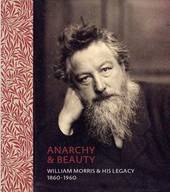
|
Anarchy & Beauty: William Morris and His Legacy, 1860 - 1960
Hardback
Main Details
| Title |
Anarchy & Beauty: William Morris and His Legacy, 1860 - 1960
|
| Authors and Contributors |
By (author) Fiona MacCarthy
|
| Physical Properties |
| Format:Hardback | | Pages:184 | | Dimensions(mm): Height 260,Width 230 |
|
| Category/Genre | Arts and crafts style
Individual artists and art monographs |
|---|
| ISBN/Barcode |
9781855144842
|
| Classifications | Dewey:745.092 |
|---|
| Audience | |
|---|
| Illustrations |
Illustrated in colour throughout
|
|
Publishing Details |
| Publisher |
National Portrait Gallery Publications
|
| Imprint |
National Portrait Gallery Publications
|
| Publication Date |
16 October 2014 |
| Publication Country |
United Kingdom
|
Description
William Morris (1834-96) regarded beauty as a basic human birthright. In this fascinating book, which accompanies a major exhibition, Morris's biographer Fiona MacCarthy looks at how his highly original and generous vision of a new form of society in which art could flourish has reverberated through the decades. In 1860 Morris moved into the now famous Red House at Bexleyheath in Kent. Here his ideas found practical expression in its decoration, undertaken with the help of his artist-craftsman friends Edward Burne-Jones, Ford Madox Brown and Dante Gabriel Rossetti, who envisaged the project as the first stage in a campaign against the debased artistic standards of the mid-Victorian age. From these beginnings, MacCarthy charts the development of a revolution: the setting-up of Morris's shop (later Morris & Co.), his embracing of radical ideas of sexual freedom and libertarianism, and the publication of his visionary novel News from Nowhere (1890), in which he advanced his hopes for a dismantling of the stultifying structures of society and their replacement by a more equable and fluid way of life. Later chapters explore how Morris's ideas came to influence the Arts and Crafts movement in Britain, Europe and the USA, the Garden City movement, and numerous artists and craftspeople who sought to negotiate a viable place within the modern world in the troubled years that followed the First World War. Finally, MacCarthy explains the continuing relevance of Morris's ideals, as expressed in the planning and execution of the Festival of Britain in 1951, a regenerative project of the post-war Labour government that inspired a number of young designers such as Terence Conran with a direct sense of mission to bring the highest design standards within the reach of everyone.
|